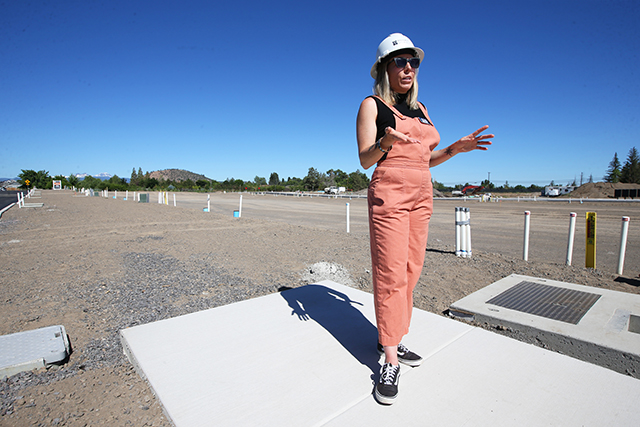The Miracle Man
Published 5:00 am Thursday, September 4, 2008

- When her husband was taken to the hospital with heart failure, Patty Roberts, of Prineville, chronicled the experience in a journal. She wrote a daily account of events and later pasted in printouts from the CaringBridge Web site she used to keep family informed.
The first of May last year was a good day for Dana Roberts and his wife, Patty. They had cleaned the yard behind their Prineville home, burned some tree limbs and other brush. They ran some errands and watched a movie and that night’s episode of “American Idol.” Dana, a 61-year-old retired Les Schwab employee, told Patty he was feeling as if he had more energy lately. It had just been a really good day.
As they went to bed that night, they had no idea how much their lives were about to change. As nice as the day had been, the next day would be just the opposite.
Trending
It would, however, reaffirm their faith in God, their friends and their community — that when something goes horribly wrong, there are people around you who will help set things right.
A frantic night
Just before midnight, Patty awoke to hear some strange noises coming from the mask Dana wore to bed. He had been diagnosed with obstructive sleep apnea, a condition in which throat muscles relax during sleep, blocking the airway. A continuous positive airway pressure machine connected to a plastic mask that fits over his mouth and nose helped to keep that airway open.
From time to time, the mask would make a funny noise and Patty would wiggle or adjust it until Dana woke up himself and set the mask right. But on this night, Dana didn’t respond.
Patty called out his name. She yelled at him. She shook him. Still Dana did not wake up. Growing increasingly frantic, she tugged at the mask, eventually breaking it to get it off his face. Dana was not breathing. Whatever she tried, she couldn’t rouse her husband.
She called 911, and the operator told Patty to start CPR until the paramedics arrived. Two Prineville police officers, Larry Seymour and Mark Monroe, arrived moments later and continued the CPR. The Robertses live less than a mile from the Crook County Fire and Rescue fire hall, and within four minutes, an ambulance and firetruck arrived with five volunteer emergency medical technicians.
Trending
The EMTs moved Dana to the floor and began CPR. The police took Patty aside to distract her from what was going on.
Jeremy Grazier, one of the EMTs who responded to the call, said the team worked hard to revive Dana. They cracked his ribs, a common occurrence when CPR is performed properly. They gave Dana a medication to lower his blood pressure and put a breathing tube down his throat.
Four times they shocked Dana’s heart with a defibrillator before they finally got a pulse. After 15 to 20 minutes, Dana’s heart was beating again.
“We worked this one for quite awhile,” Grazier said.
At the hospital
With Dana somewhat stabilized, the paramedics could then take him to Pioneer Memorial Hospital in Prineville. A neighbor saw the emergency vehicles outside their home and came by to see if they needed any help. She drove Patty to the hospital, following the ambulance.
At Pioneer, Dr. Chris Richards, an emergency physician, took over care. Within an hour, he determined Dana needed to be airlifted to St. Charles Bend. As pilot Ken Cox flew the helicopter, flight nurse Deidre Heinrich and respiratory therapist Kim Reed monitored Dana for any change.
“He was very ill, on the verge of death,” Heinrich recalled. Fortunately, it was an uneventful 15-minute flight.
Meanwhile, Patty called another friend at 1:30 in the morning and asked her to drive her to Bend.
When Dana arrived at St. Charles Bend, doctors noted he was not moving at all, a sign his neurologic system was not functioning normally.
“The brain was not processing at all what’s going on around him, and thereby not able to be responsive to it,” said Dr. Keith Harless, an intensivist who oversaw Dana’s care at St. Charles.
Doctors were concerned that the lengthy time Dana had gone without oxygen would mean that even if he did recover, he might have substantial brain damage.
“They were not giving us a lot of hope,” Patty said. “The ER doctor came out and said he definitely did get sicker on the trip.”
Early in the morning on May 2, doctors fitted Dana with a cooling blanket known as the Arctic Sun.
“It is a device that has pads that go around the chest and go around the thighs, and those pads are circulated with cold fluid. It effectively cools the body temperature nicely,” Harless said. “It substantially reduces oxygen consumption by the brain, as well as the whole body. And by so doing, the brain can heal itself and not have further injury.”
The blanket brought Dana’s body temperature down to 90 degrees, essentially inducing hypothermia. Then it was a waiting game. If he didn’t come around after 48 hours, there would be little hope.
“It was scary. It was kind of a numbness,” Patty recalled of those first days. “All kinds of things go through your mind. I was up all that night. But of course the next night, I went to bed thinking I wouldn’t have a husband any more.”
Signs of hope
Patty can’t remember exactly when, but somewhere in the initial days of the ordeal, a friend suggested she keep a journal to chronicle the events. She began to record each day’s events, who was caring for Dana, who came to visit, and what happened. She began posting updates to CaringBridge.org, creating a page where family and friends from far away could track what was happening. Throughout the country, people prayed for Dana and posted messages of support to the Web site. Patty was joined at the hospital by their four children and four grandchildren.
The next morning, May 3, neurologists examined Dana and again told the family there was little chance he’d survive, much less be able to resume a normal life. They told Patty she might soon have to make a decision whether to keep Dana on life support or turn off the machines.
As she prayed and wrestled with the choice before her, Dee Lovejoy, a critical care nurse, approached her in the waiting room at about 2:30 in the afternoon. Patty’s heart sank, but the nurse assured it was good news. Lovejoy had asked Dana to squeeze her hand and he responded.
“I just couldn’t believe it,” Lovejoy says. Dana had arrived in such poor shape, the nurses were not expecting him to make it. She ran out to the waiting room to tell his wife.
“It was the most awesome news,” Patty said. “My daughter was in there with me and she came out saying, ‘I think he responded to me. I know he’s in there.’ But because of what the doctors said, I didn’t want to get my hopes up.”
X-rays confirmed Dana had broken ribs and a punctured lung. Doctors inserted a drainage tube in his side. At one point, Patty counted 14 intravenous drips going at the same time. Over the next three days, doctors and nurses slowly cut back on his medications and sedatives. As he would start to awaken, he would quickly become agitated and nurses had to keep his hands tied down so he wouldn’t pull out the ventilator tube.
By May 6, Dana was starting to come around. Doctors removed the breathing tube and cut back further on his medications. Still groggy and confused, he made his first request. He was hungry and wanted ice cream.
“He was so funny!” Patty recalled. “He was cracking all of us up because he was taking all of those drugs. It was just a fun time.”
Later that afternoon, he correctly identified Patty as his wife.
When Patty entered Dana’s room the next day, he cracked a joke. “Wanna go to bed?” he said playfully. He asked for a Coke, but nurses said he could only have ice chips. Patty spent much of the day feeding him ice chips. He was disappointed he had missed “American Idol” the previous night.
Day after day, Dana continued to improve. It was dawning upon Patty that he might actually be OK. Doctors were still unsure exactly what had happened to Dana. They suspected that his sleep apnea might have triggered heart failure, but tests showed he hadn’t had a heart attack. He might have avoided damage to his heart muscle, increasing the chance of recovery.
Dr. Jason Wollmuth, a cardiologist with Heart Center Cardiology in Bend, was called in to do an angiogram, basically a picture of the heart arteries that can reveal blockages.
“We’re usually involved from the get-go, but they honestly thought he wasn’t going to make it,” Wollmuth said. “He had been down for so long that they thought he was not going to recover. So they didn’t call us.”
But Dana would have to lie flat for the procedure, and the combination of his broken ribs and the fluid in his lungs made that a difficult task. Doctors decided to postpone the test until he felt better.
Grazier, the EMT who had helped resuscitate Dana, stopped by to see him. Dana had volunteered for the fire department for 11 years, and Grazier was thrilled he could help out “one of our own.”
“It’s a brotherhood with the fire department,” he said. “You want to make sure that everything’s taken care of, that they don’t need anything else.”
Emergency personnel often don’t know what happens with patients after they’re taken to the hospital, and Grazier knew that Dana faced long odds.
“There’s nothing more rewarding than being able to go home at the end of the day and know you’ve saved one person,” he said. “It’s an amazing feeling.”
The Miracle Man
Dana got stronger every day, and on May 9 he was transferred from Critical Care to the Intensive Care Unit. The next day he walked with the help of a specialized cardiac walker. On May 14, doctors finally performed the angiogram, which showed Dana had multiple blocked arteries and would need bypass surgery.
The night before the surgery Patty stayed in Dana’s room. He had told her he wished he had someone to talk to and he missed her. On May 16, Dr. Angelo Vlessis performed the bypass surgery. All went well, and Patty started to refer to Dana in the journal as The Miracle Man.
His doctors agreed that Dana had in many ways beat the odds.
“It’s just a remarkable story that he made it through,” Wollmuth said. “His (cardiac) arrest was out of the hospital. The chances of surviving an out-of-hospital cardiac arrest are about 5 percent.”
And many of those patients never return to a normal life.
“They get discharged from the hospital, but that doesn’t mean they get discharged back to who they were,” said Dr. Hugh Adair, Dana’s cardiologist at the Heart Center. “They get discharged to the nursing home or to a ventilator. He’s back to who he was.”
Doctors say there were several key factors that probably contributed to his survival. The fact that Patty noticed quickly that Dana had stopped breathing and called 911 was critical. Patients whose heart failure is witnessed by somebody have a much higher chance of survival. Efforts by Patty and the police officers to start CPR before the paramedics arrived increased the odds, as did the quick response by the paramedics.
It was only a few months earlier that Crook County Fire and Rescue implemented a new CPR protocol, which has been shown to improve survivability for those suffering heart failure. And the availability of the Arctic Sun, a device not all hospitals have access to, likely helped Dana recover without significant damage.
“Since I’ve been here, I’ve had a number of people who have gotten that and had really good outcomes,” Wollmuth said. “What component does that play in it? In any individual it’s really hard to say. The data is certainly promising so you have to think it had some role.”
Coming home
After three weeks, doctors were ready to send Dana home. They wanted to perform a heart stimulation test first to see if he would need an implantable defibrillator. But the only electrophysiologist in Bend was on vacation. They sent Dana to St. Vincent’s Hospital in Portland instead.
After an ambulance ride over the Cascades, the test revealed his heart was doing well, and after 24 days in the hospital, he could finally go home. It was only then that Dana saw Patty’s journal for the first time.
“He would just sit there and read it and go, ‘Wow. Wow,’” Patty said.
Dana read the handwritten pages that chronicled his ordeal and recovery. Patty had pasted in the updates from the CaringBridge Web site — and page after page of well-wishes.
“When I first came home and I read it, it really didn’t sink in. I was still on painkillers, but once I got off the pain medicine, I could really decipher what was going on,” Dana said. “It was pretty touching because there were people in London and all over the world who got on the Internet.”
He read of the incredible number of people who had a hand in saving his life. From the first responders to the doctors, to the countless nurses who brought him back to health and the therapists who worked to get him back on his feet. Patty counted no fewer than 16 doctors. She tried keeping track of all of the nurses, but well into the second dozen, it became an impossible task. She recorded two full pages of family and friends who visited, called or sent cards, gifts and food.
Dana still gets a bit teary-eyed when he thinks of all that went into his recovery. He attributes his survival both to his faith and to the multitude of individuals in the community health care system who were there in his most dire hour.
“It not only meant a lot for me, it meant a lot for a lot of people. A lot of people were praying,” Dana said. “I want to thank God first, but I want to thank St. Charles and those doctors and the paramedics in Prineville for a job well done.”
Medical personnel who helped
Jeremy Grazier
Crook County Fire and Rescue
Josh Guinn
Crook County Fire and Rescue
Andrew Lake
Crook County Fire and Rescue
Tim Gorton
Crook County Fire and Rescue
Wayne Muilenburg
Crook County Fire and Rescue
Larry Seymour
Prineville Police Department
Mark Monroe
Prineville Police Department
Dr. Stephen Ireland
Neurology of Bend
Dr. Gavin Noble
Bend Memorial Clinic
Dr. Andrew Higgins
Bend Memorial Clinic
Dr. Keith Harless
Bend Memorial Clinic
Cassi Dixon
Heart Center Cardiology
Dr. Jason Wollmuth
Heart Center Cardiology
Dr. Hugh Adair
Heart Center Cardiology
Dr. Chris Richards
Pioneer Memorial Hospital
Dr. Angelo Vlessis
Cardiothoracic Surgeons
Dr. Randall Jacobs
Bend Memorial Clinic
Dr. Matthew Hegewald
Bend Memorial Clinic
Eric Diline
Bend Memorial Clinic
Dr. Randy Jones
St. Vincent Memorial Center
Ken Cox
AirLink
Deidre Heinrich
AirLink
Kim Reed
AirLink
Nurses:
Dee, Lori, Debbie, Shellie, Leanne, Heather, Chris, Louise, Marita, Sarah, Rory, Lisa, Shannon, Lauren, Shonda, Marie, Selena, Andrea, Michael, Dave, Mike, Steve, Sue, Chris, Roxie








